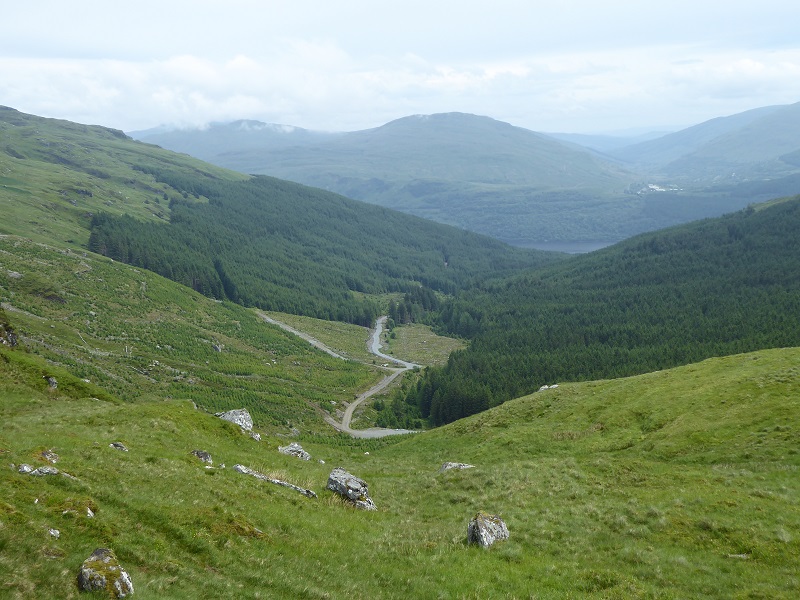
Since my post in June (see here) on Forest Enterprise’s “upgrade” of the Coilessan Glen forest track, I have been trying to get to the root of what has gone wrong. First I established that no planning application or prior notification had been received by the Loch Lomond and Trossachs National Park Authority, then I took the matter up with Simon Hodge, Chief Executive of Forest Enterprise Scotland. I believe my correspondence with him shows there are serious issues about how the Forest Estate is being managed in the Loch Lomond and Trossachs National Park and will highlight evidence for this in this post (you can view the full correspondence below).
The Prior Notification System and the track upgrade
Forestry Tracks are, under planning legislation, classed as permitted developments but under the Prior Notification System all new or alterations to existing forest tracks are supposed to be notified to the Planning Authority. FES is usually good at doing this, and indeed has now done so for two small changes to the track in Coilessan Glen. However, they disputed my claim that all the track upgrade and other works needed prior notification, claiming these were “maintenance” rather than alterations.
In response I sent them some photos:

FES response to photo:
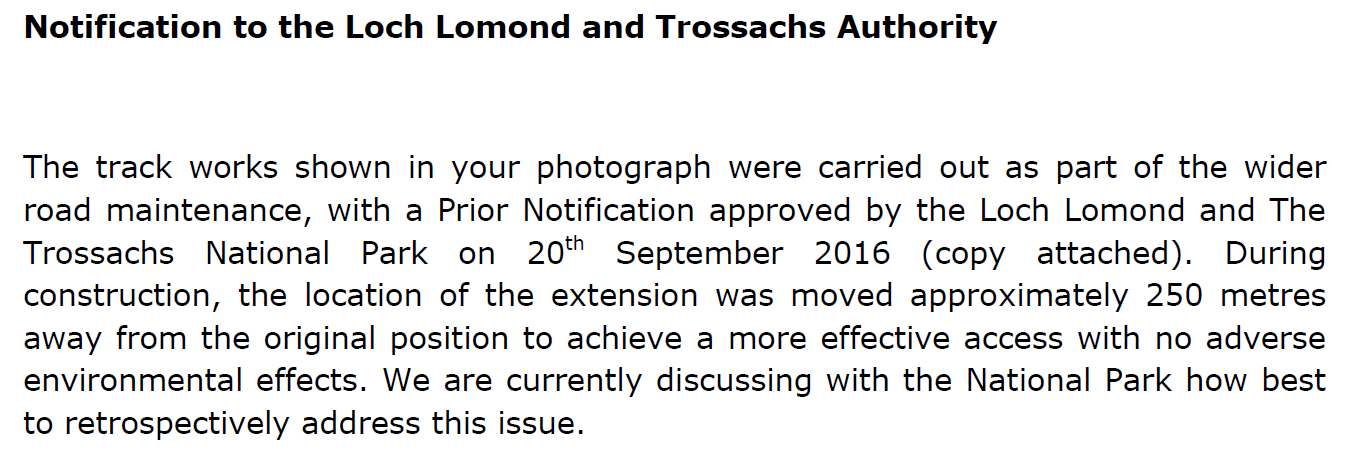
In plain language this is an acknowledgement from FES that the works included a new section of track which they should have notified to the LLTNPA under the Prior Notification System. However, they try and excuse this failure by saying they had told the LLTNPA about a new section of track in Coilessan Glen but in a different place, 250m away! Imagine someone trying to justify building a house in one place on the grounds that the planning authority had accepted this in a different location!
The LLTNPA’s response to that Prior Notification (link to full letter below under correspondence) is telling:

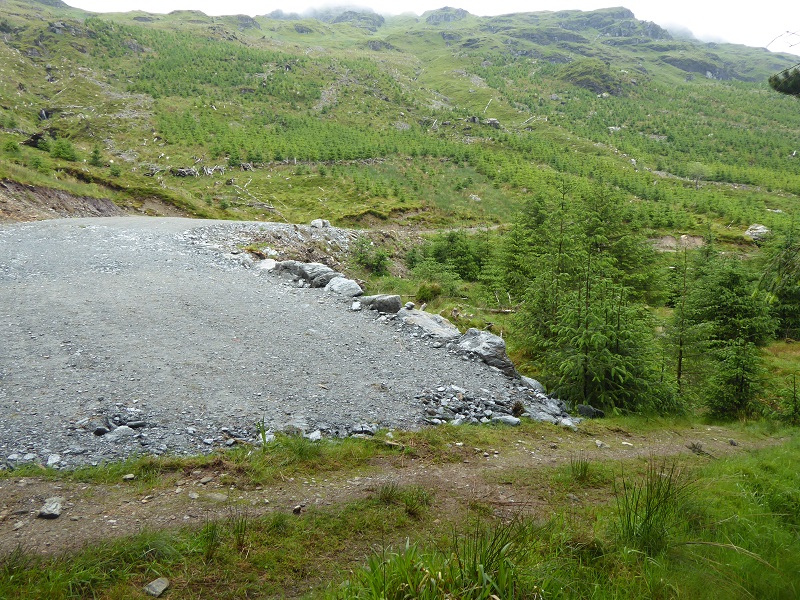
This extension is according to standard FES designs and therefore its reasonable to say that the original 250m away would have had a similar landscape impact. Yet the LLTNPA was quite happy to state in response to the Notification that such extensions do not raise “any significant landscape” concerns. I don’t think any recreational walker would agree. The works have had a serious adverse impact on the Cowal Way. The LLTNPA needs to ensure its staff and Board Members get out more and review their policy in this area. I know the LLTNPA and other public authorities are strapped for resources but this is simply not good enough for a National Park. At least according to the correspondence FES and LLTNPA have now met to discuss what to do about this section of track. Now both need to explain publicly what they will do to restore the damage to the National Park landscape.
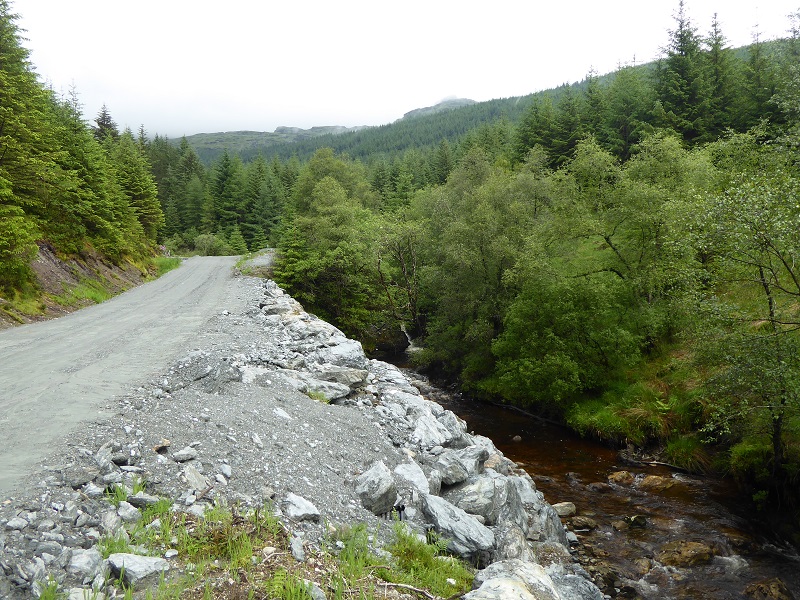 FES response to photo:
FES response to photo:
 By saying this, FES seem to be trying to imply that this work to reinforce the side of the track is not an alteration but maintenance. They have however accepted, by calling in the Scottish Environmental Protection Agency, that the works could have serious ecological implications (with silt eroding into the river). Reason enough one might have thought to notify the LLTNPA.
By saying this, FES seem to be trying to imply that this work to reinforce the side of the track is not an alteration but maintenance. They have however accepted, by calling in the Scottish Environmental Protection Agency, that the works could have serious ecological implications (with silt eroding into the river). Reason enough one might have thought to notify the LLTNPA.
Apart from the technicalities of the failing Prior Notification system, the substantive issue is that FES has trashed what would otherwise be an attractive section of river. In the current Ardgarten Forest Design Plan (which is not publicly available although FES are now publishng new forest plans as they are agreed) all the main riparian edges in Coilessan Glen were designated for native woodland. Good plan, shame its being ignored.

FES response to photo:

The evidence shows that what has been done is more then vegetation removal. Scottish Government Guidance on tracks and the Prior Notification system SG FinalGuidance june 15 Smith et al 2014 states:
“The distinction between”alteration” and “maintenance” may sometimes be difficult to determine. Maintenance‟ work could include routine repairs to private ways such as filling potholes or clearing drainage channels or replacing culverts in line with recommendations and guidance by SEPA to comply with good practice.
Work such as resurfacing to provide a materially different road surface (for example replacing loose gravel with tarmacadam), or to widen or extend a track, would generally be considered an “alteration‟.
While I believe the Coilessan tracks have been altered, whatever the Prior Notification technicalities the substantive issue is why FES is allowed to do work like this in the National Park? The slope is too steep, will erode rather than re-vegetate and contrary to good practice (such as contained within the LLTNPA Guidance on Renewables). The LLTNPA should be demanding that Forestry Commission Scotland, which agrees the standard specifications for forest tracks, to review them to ensure they are fit for National Parks (and other areas of landscape importance in Scotland).
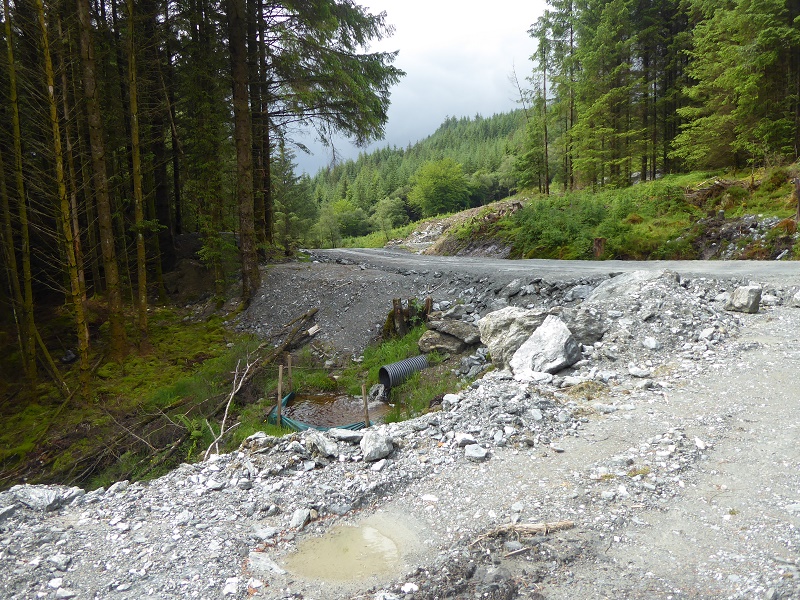 FES response to photo:
FES response to photo:
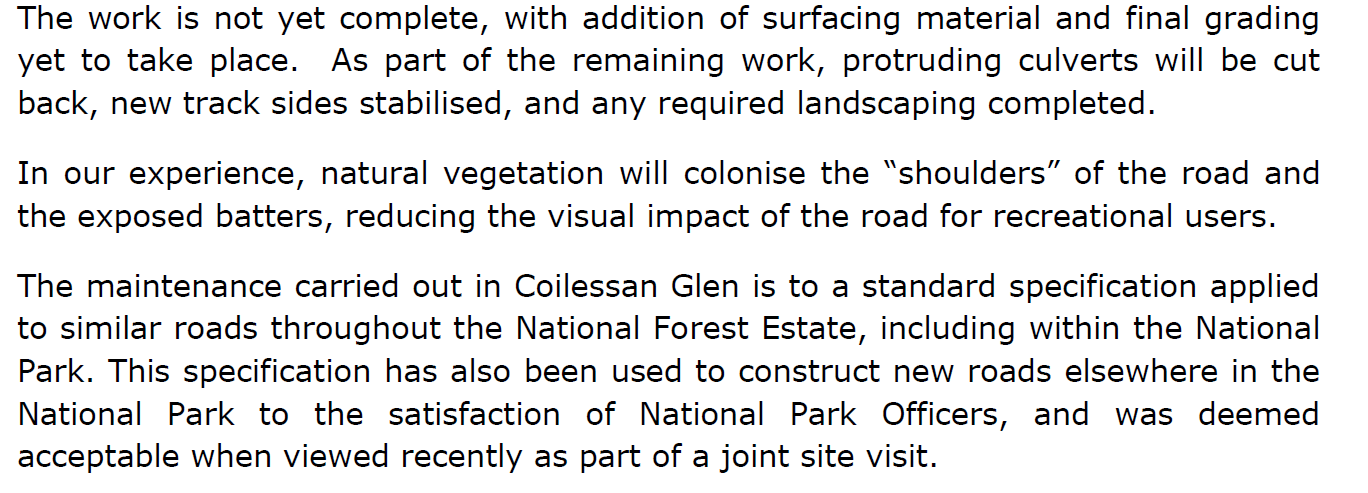 Accepting FES assurances that the work is not complete, it is disturbing that National Park Officers apparently have deemed the work at Coilessan acceptable. Do they not even think further monitoring is required to see that any restoration work by FES is acceptable? I would like LLTNPA Board Members to go out – preferably in the company of people who have an interest in our landscape and nature conservation in our National Parks – take a look and re-think.
Accepting FES assurances that the work is not complete, it is disturbing that National Park Officers apparently have deemed the work at Coilessan acceptable. Do they not even think further monitoring is required to see that any restoration work by FES is acceptable? I would like LLTNPA Board Members to go out – preferably in the company of people who have an interest in our landscape and nature conservation in our National Parks – take a look and re-think.
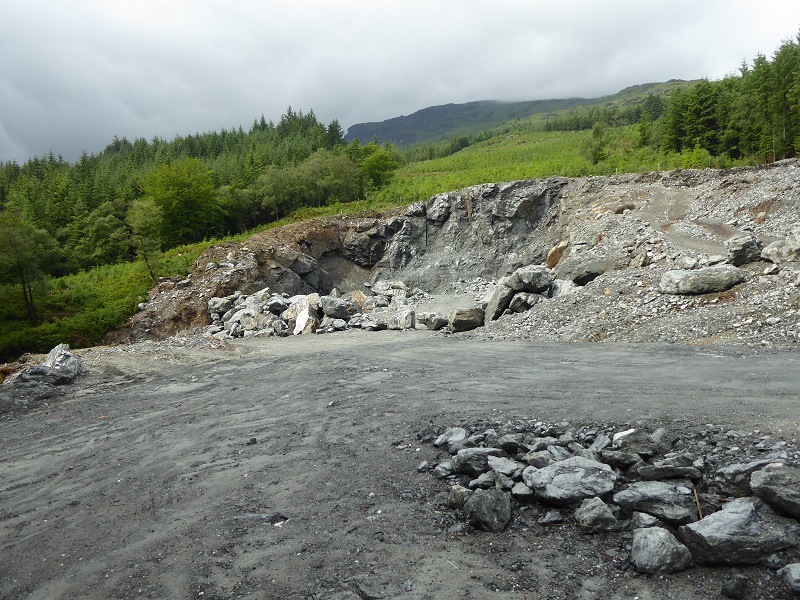
FES response to photo:

So, quarries can be built and extended in National Parks outwith the planning system. I am grateful that FES sent me the letter from FCS EIA101 Ardgartan Quarry – even if it basically attributes responsibility for this to them – although they have made no mention of the mitigation measures which FCS said needed to be agreed with the LLTNPA and are not anywhere public on the Park’s planning portal. While I will pursue this, the substantive issues is that quarrying does not have to look like this. Here is an alternative example from the Cairngorms National Park I came across last weekend:
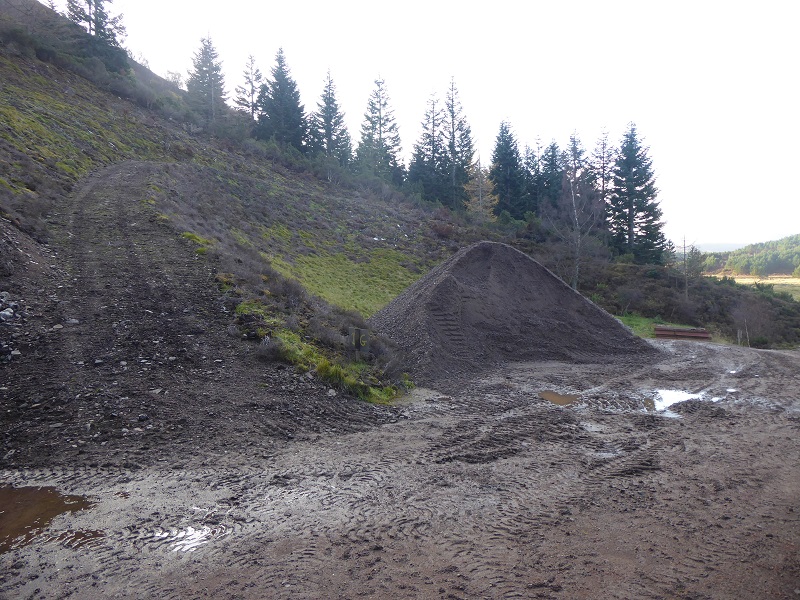
In Glen Tromie (which I will blog about in due course because of the positive lessons there for the rest of Scotland) the estate are restoring the quarry as they go, a complete contrast to FES. The contrast in how the land is being treated and landscape respect is in my view stark.
The new Prior Notification for a 70m section of track in Coilessan Glen
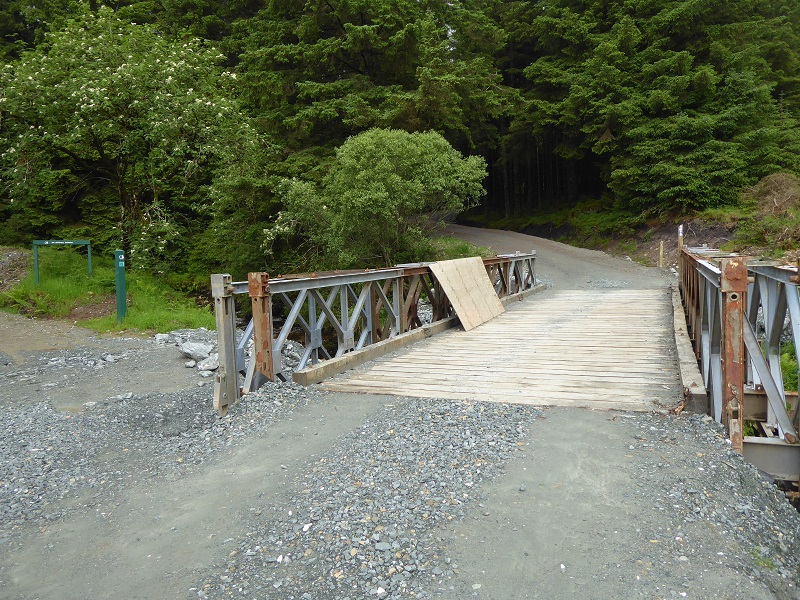
At the beginning of October, FES submitted a Prior Notification to the LLTNPA for further work in Coilessan Glen – to “straighten” the section of track beyond the bridge in the photo above. The response of the LLTNPA was that this did not need Prior Approval (see here) because:

Leaving aside the implication that any forestry road deemed commercial can go ahead in the National Park without any consideration of landscape or conservation issues, the LLTNPA has failed to properly consider the issues as this extract from the second FES letter shows:

First, FES are now claiming the track is needed in case there is a need to fell larch trees in an attempt to prevent the spread of Phytopthera Ramorum, a disease that is decimating larch plantations across the UK and not for normal commercial forestry purposes. Second, FES are not proposing to remove the old track but to leave it in place, so there will be two tracks at this point in the glen for what appear to be spurious reasons. (I had been rather hoping they might use the opportunity to reduce the old track to footpath width so improving the walking experience on the Cowal Way). So why did the LLTNPA not ask what was happening to the 70m section of old track before simply approving the new one? If this is anything to go by it appears the LLTNPA are simply rubber stamping FES Prior Notifications without any consideration of the landscape or conservation implications.
What needs to happen
The issues raised here are much broader than the track in Coilessan Glen and have implications for the whole of the Argyll Forest Park. When the Loch Lomond and Trossachs National Park was originally proposed, Cowal was not included, but this changed as a result of local pressure. Part of this was because local people thought a National Park might be a way of changing how forestry was managed in the Argyll Forest Park.
Initially the LLTNPA did take an interest in Argyll and a new forest framework was produced lltnpa woodland framework action area 3. (This is not publicly available – the FES appears to have just one copy – but I am very grateful for the FES planning section for copying the relevant part of this and sending it to me by return without an FOI request). While this did not propose a radical change of direction – it clearly states that commercial forestry would predominate – it did set out some aspirations and suggested areas for change (on some of which there has since been progress). The problem is that the thinking behind the framework has never been reviewed or developed despite opportunities to do this, mostly recently in the draft National Park Partnership Plan consulted on earlier this year.
The most important thing that I believe needs to happen therefore is that the new National Park Partnership Plan should commit both the LLTNPA and FCS/FES to a public a review of Forest Management in the Argyll Forest Park and how this meets the National Park’s statutory objectives. While the spread of Phytopthera Ramorum – a conservation disaster which I will come back to – is another reason to do this, the failed operation of the Prior Notification system in Coilessan Glen and the landscape and conservation impact of track works there should in themselves be sufficient. It will be interesting to see if the final National Park Partnership Plan due to be presented to the LLTNPA Board in December says anything meaningful about changing forestry practice in the Argyll Forest Park.
Addendum – correspondence with FES
- 30/08/17 Email (see here) and link to my June post sent to Simon Hodge asking if agreed the Coilessan track works should have been notified to the LLTNPA
- No acknowledgement
- 19/09/17 Polite reminder sent (see here) with my MSP, who everyone knows as Nicola, copied in. Hey pronto, immediate (same day) acknowledgement
- 22/09/17 Response claiming Prior Notification not required as work within “footprint” existing tracks, that the final “running track” would be narrower and that the tracks were needed to control Phytopthera Ramorum Final response to Mr Knowles
- 02/10/17 Follow up letter sent with photographic evidence disputing FES claim that works within existing footprint Letter to Simon Hodge, Coilessan 171002
- No acknowledgement
- 17/10/17 Polite reminder sent (see here), noting further issues raised by recent notification to LLTNPA of work to straighten a section of track in Coilessan Glen, with my MSP once again copied in. Hey pronto, acknowledgement!
- 25/10/17 Response (see here), treated as Information Request, with two attachments: the first the LLTNPA response to a prior notification in 2016 for a new 50m section of track at Coilessan (on planning portal) (see here); the second, the response from Forestry Commission Scotland EIA101 Ardgartan Quarry saying an Environmental Impact Assessment was not needed for the quarry which has been used to source material for the tracks
- 10/11/17 provision of Ardgarten Forest Plan (document too large to provide on website) and lltnpa woodland framework action area 3 by FES planning department.
The timing of the responses from FES is a neat illustration that when it comes to senior personnel in public authorities its not what you say that matters but who you know.
Hi,
I was cycling around the ardgarten peninsula yesterday 20/04/19 and was alarmed to see the large quarry operations on the dukes pass. The quarry works is effectively closing the main dukes path forest road used for cycling and walking, just below Corrie lochan. There is no alternative route or advice on safe alternative. On speaking to site workers we were allowed to pass the quarry to continue on route, but there is no cordon in places , safely separating walkers or cyclist from quarry work. This is an extremely famous MTB route and well known as part of the new wild about Argyll bike touring route, so sad that access may well be restricted due to the quarry work, surely planning permission should never have been granted for the quarry to be on such a well used public path.